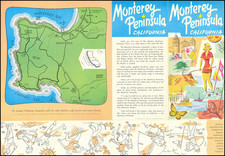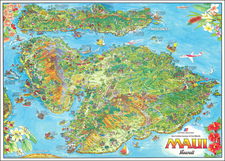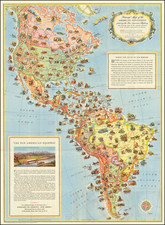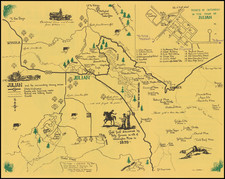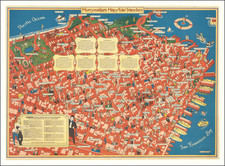Waterfront Improvement Plan of the East Bay Drawn By The Father of Modern Space Art
Hand drawn map illustrating a shoreline improvement plan of the East Bay, centered Berkeley, drawn by renowned American space and science fiction illustrator Chesley Bonestell.
While we have not been able to identify the specific project for which the map was drawn, we surmise that the work was done by Bonestell during the time he was working on ideas with Joseph Strauss, the chief engineer for the Golden Gate Bridge, in connection with proposals relating to the 1939 Golden Gate International Exposition. Similarly, the dating on the map is somewhat of a mystery. While previously given the date of 1945 (in the title), we believe the map was drawn in about 1936.
The proposed project included 9.5 Square Miles of Land Fill, as noted below the legend. Oriented with west at the top of the map, Bonestell's drawing stretches from Alameda Island and Estuary at the far right to Richmond, illustrating enough of San Francisco, the Bay Bridge, Alcatraz and Angel Island to provide geographical context.
The focus of the plan is on the Oakland and Berkeley side of the Bay, describing coastal and pier development from the Alameda Naval Airfields to Point Richmond. Main roads, residential and industrial areas, an exposition park, bird sanctuary, Union Station, and the University of California are some of the specific references found on the map. Specific areas on the map are reserved for:
- Airports (Alameda and Berkeley)
- Railroads
- Industries
- Industrial Village
- Small Homes
- Bird Sanctuary
The map shows an unnamed Treasure Island, an artificial island in the San Francisco Bay, which was built in 1936–37 for the 1939 Golden Gate International Exposition.
A few decorative motifs commonly found on sixteenth-century maps such as sea monsters, a wind-head compass, an ornate distance scale and title cartouche proved too tempting for the imaginative Bonestell not to include in his composition.
History Behind The Map
The map includes 3 dates, a 1945 date in the title, a reference to a 1932 chart for soundings, and a note stating "Existing Shoreline of 1936."
Based upon biographical and historical data, it would seem to make the most sense that the map was drawn in about 1936, about the time of the construction of the Berkeley Yacht Harbor. In the late 1930s, Bonestell moved to Hollywood. Prior to that time, he prepared illustrations of the chief engineer's plans for the Golden Gate Bridge. The location of the Old Berkeley Pier and U.S. Pierhead and discussion of land fill areas which never happened strongly suggests a pre-WWII date.
The map may be related to a project undertaken by Bonestell at about the time of the planning for the 1939 Golden Gate International Exposition. In the 1930s, Bonestell had been actively engaged in working with the chief architect of the Golden Gate Bridge, Joseph Strauss. One of Strauss's major projects was his idea for the design of the site for the World's Fair. The University of California Berkeley and Oakland Public Library have a number of illustrations by Bonestell related to the World's Fair Project.
Further evidence of the later dating of the map is the unnamed Treasure Island, which was built in 1936-37 for the 1939 Golden Gate International Exposition. The primitive information on the Island reflects the plan for an airport on the island and 3 structures on the south side of the island, nearest to Yerba Buena Island, as illustrated in early drawings. http://www.sparkletack.com/wp-content/img/podcast_img/63/airportsketch.jpg
Originally constructed as an airport for Pan Am’s line of Trans-Pacific “flying boats,” the illustration here clearly pre-dates the construction for the fair.
Based upon the totality of the illustration and the use of the name "Exposition Park" adjacent to the Berkeley Marina, our assumption is that this was an early rendering for urban improvements done by Bonestell during his work for the 1939 Exposition.
Cheley Bonestell was an American painter, designer and illustrator. His paintings inspired the American space program, and they have been (and remain) influential in science fiction art and illustration.
A pioneering creator of astronomical art, along with the French astronomer-artist Lucien Rudaux, Bonestell has been called the "Father of Modern Space Art".
His first astronomical painting was done in 1905. After seeing Saturn through the 12-inch (300 mm) telescope at San Jose's Lick Observatory, he rushed home to paint what he had seen. The painting was destroyed in the fire that followed the 1906 earthquake. Between 1915 and 1918 he exhibited lithographs in the 4th and 7th annual exhibitions of the California Society of Etchers (now the California Society of Printmakers) in San Francisco.
Bonestell studied architecture at Columbia University in New York City. Dropping out in his third year, he worked as a renderer and designer for several of the leading architectural firms of the time, including the firm of Willis Polk, "The Man Who Rebuilt San Francisco."
Bonestell moved to England in 1920, where he rendered architectural subjects for the Illustrated London News. He returned to New York in 1926. While with William van Alen, he and Warren Straton designed the art deco façade of the Chrysler Building as well as its distinctive eagles. During this same period, he designed the Plymouth Rock Memorial, the U.S. Supreme Court Building, the New York Central Building, Manhattan office and apartment buildings and several state capitols.
Returning to the West Coast, he prepared illustrations of Joseph Strauss's plans for the Golden Gate Bridge and later completed artwork associated with Strauss's urban planning ideas for the 1939 San Francisco World's Fair. At the time, Bonestell was considered one of the most important and influential commercial artists in the Bay Area, serving as the chief designer in Willis Polk’s office in Berkeley.
In the late 1930s, Bonestell moved to Hollywood, where he worked (without screen credit) as a special effects artist, creating matte paintings for films, including The Hunchback of Notre Dame (1939), Citizen Kane (1941) and The Magnificent Ambersons (1942).
Bonestell then realized that he could combine what he had learned about camera angles, miniature modeling, and painting techniques with his lifelong interest in astronomy. The result was a series of paintings of Saturn as seen from several of its moons that was published in Life in 1944. Nothing like these had ever been seen before: they looked as though photographers had been sent into space. His painting "Saturn as Seen from Titan" is perhaps the most famous astronomical landscape ever, and is nicknamed "the painting that launched a thousand careers." It was constructed with a combination of clay models, photographic tricks and various painting techniques.
Bonestell followed up the sensation these paintings created by publishing more paintings in many leading national magazines. These and others were eventually collected in the best-selling book The Conquest of Space (1949), produced in collaboration with author Willy Ley.
Bonestell's last work in Hollywood was contributing special effects art and technical advice to the seminal science fiction films produced by George Pal, including Destination Moon, When Worlds Collide, The War of the Worlds and Conquest of Space, as well as Cat-Women of the Moon. Beginning with the October 1947 issue of Astounding Science Fiction, Bonestell painted more than 60 cover illustrations for science fiction magazines, primarily The Magazine of Fantasy & Science Fiction, in the 1950s through 1970s. He also illustrated many book covers.
When Wernher von Braun organized a space flight symposium for Collier's, he invited Bonestell to illustrate his concepts for the future of spaceflight. For the first time, spaceflight was shown to be a matter of the near future. Von Braun and Bonestell showed that it could be accomplished with the technology then existing in the mid-1950s, and that the question was that of money and will. Coming as they did at the beginning of the Cold War and just before the sobering shock of the launch of Sputnik, the 1952–54 Collier's series, "Man Will Conquer Space Soon!", was instrumental in kick-starting America's space program.









